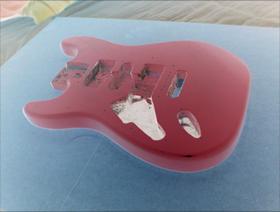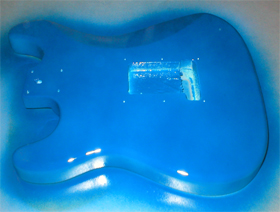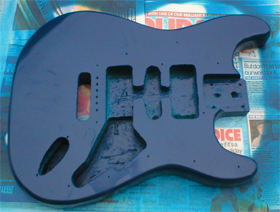Quick-Fix: Re-Spraying Your Guitar
Posted by Shredaholic on 9/02/05 • Categorized as Tech
How to paint a guitar in the colour of your choice.
There are several different ways to paint a guitar. For this website I’m going to be concentrating on the easiest way, and if anyone out there wants to have a go at painting their own guitar you’d be better following this easy way rather than a complicated one.
DISCLAIMER: This guide is not exhaustive in the slightest. I have provided this as a quick reference as to how to paint a guitar. For fuller, more in-depth guidance, try ordering the e-books coming soon from Shredaholic.com. Also, my links page shows websites which have more comprehensive guidance. I will not be held responsible for anyone who does not achieve their desired finish.

Take the gloss lacquered finish off of the guitar. As you can see in this picture, the sheen has been removed.
Step 2
You need to sand the body down so that the primer will stick evenly to the body (and not run off the sheen), and then the paint sticks  to the primer. The advantage with using aerosols is that they’re cheaper than a professional spray gun and readily available – you can get them from most shops that sell bits for cars, as car spray paint is the same stuff!
to the primer. The advantage with using aerosols is that they’re cheaper than a professional spray gun and readily available – you can get them from most shops that sell bits for cars, as car spray paint is the same stuff!
Tip: To avoid doing what I had to do (I had to paint in my garage due to the ‘great’ British weather…) suspend the guitar body from a washing line or similar, using a bit of wire through the neck holes. This way you can walk around the guitar and get both sides of the guitar done at once.
Leave this to dry then build up another couple of coats, until you have a grey, matt-finish guitar.
 Step 3
Step 3
Sand the body, start spraying the paint
Tip: Do not worry if your first couple of coats do not seem to be matching to the colour you bought. They will react with the primer (and also the colour underneath) and probably give you a lighter coat. This will disappear with every coat you apply. Remember you will probably need five or six coats to achieve a full, gloss finish.
The following pictures show the colour differences between coats – the first picture is after only two coats,  the second is after five. (This is the guitar from project-strat.com)
the second is after five. (This is the guitar from project-strat.com)
Painted. Notice the difference in colour between coats (the more coats the deeper the colour).
Step 4
Once you have applied the final coat, and the finish is to your liking, leave to dry overnight. Tip: If you are planning on applying any custom decals to the guitar, you may wish to apply them now, so that they will be under the lacquer.
At this stage it needs to be clear coated. When this is finished, and you have applied the final coat of lacquer, leave this to dry for a day or two. Once this has dried, pick it up and admire your work. Congratulations! You have painted your guitar body.
Van Halen build notes
As my guitar was going to be a replica of Eddie Van Halen’s guitar, there are details to note. The nature of the design means that I had to use 2 different colours, black and white. In order to paint this successfully I had to buy black and white spray paint cans, and different types of masking tape. The tape widths were 3/4 inch for the wider stripes and 1/8 inch for the thinner black stripes. I managed to buy a roll of 3/4 inch tape, but for the 1/8 inch tape I had to go to my local model shop and purchased yellow ‘Tamiya’ masking tape which I used to make model kits with when I was younger (this still had to be cut down to size however).

I left the guitar with no gloss finish like the original, but now I regret doing so. It is important to protect the finish in addition to making it look glossy. Logos from T-shirts I’ve worn while playing have rubbed against the finish of the guitar and left some sort of green residue, and is incredibly hard to get out. The guitar also gets dented easier. If you feel you can live with that however and want to go for originality, by all means do so.

(Thanks to project-strat for information for the article)












Using enamel is your first mistake. And anything over 4 coats will suffocate the piece, it needs to breath period. nitrocellulose lacquer, everything else is shit. I’m a musician, auto painter, and wildlife artist, 60 yrs old and have read every piece of crap scrawls on how Tao’s for years stick to lacquer, seal the bare wood that has been sanded with 2000, seal with a lacquer primer, put enough on to cover the wood let dry 1-2 hrs wet sand down until you can see where you might take all the primer off and stop. Now the lacquer primer has bonded to the wood , now put two heavy coats on and wet sand again drawing from the experience of the first sanding you can and have to guess to remove one coat the closer to the wood the better. let dry over night tack with a tack cloth and apply color, color coats are thinner, now heres the trick let the first color coat dry, over night then wet sand with 678 or 900 wet dry tack add final coats 3 should do let dry over night wet sand 678-900 just skiff the surface using a flat sanding board, I just use my metal diamond fret leveler and tape the paper to it try to get one of the coats off let dry and hand buff, M rubbing compound is the best that I have found its not as abrasive as all the others so it cuts a little slower but a hell of a lot better. In this stage take your time, when you have done all you can with the M (and it will tell you when to stop and thats why I love the stuff) go to a turtle wax polishing compound very fine stuff clean and leave alone DO NOT WAX WAX IS A SEALER AND YOUR PIECE WONT BREATH. I also put mine in the oven off and on fore a few days on very low heat no hotter than a hot summer day because alto of guitars out there are cut by machines sealed with ploy f______urethane you might as well use barn paint if you go that rough. take your time, take your time. Set up so you can rotate it in front of you, this is a fine piece of wood you have give it some attention. Also the neck has to fit snug no paint in the neck cavity teak oil after checking tolerances 0 tolerance. I take my steel flat bar with 400 wood sand paper not wet and dry and skiff the surface of the bottom of the cavity, take a pencil and cover the bottom of the cavity BE CAREFUL take some plastic from a milk carton and use it for a bumper in the front of the cavity so you dont bang dints in it 0 tolerance is the goal, a ton of tone is transfered throngh this cavity TAKE YOUR TIME you might want to build the header (the front barrier closest to the pickup in the neck position 1-16 or 1-64 thousandths to fill here and sand find a small hardwood trim board with the sand paper (400) on the face portion to sand the filler because it has rounded edges and is better (less gouging) use carpenters wood filler by Elmers it is finer and any fine filler will work. check the screws set the neck and you should be just a fraction foreward and this will draw up forward toward the head. They say the best is the natural wood but your not going to find that on one guitar in the known universe Elmers will transfer tone. Get the cavity right and its like a neck through that you can take off and go kick some ass on the weekend unless your playin have fun lioke thissight
Zombiwolf
Hi, i’ve got a few questions about this article, if your okay to answer them please?
1) At the start do you sand down to the wood or just the top layer of paint to rough up?
2) What type of primer are you using?
3) What gage of sandpaper are you using to sand the primer down?
4) What type of lacquer are you using?
I’d be very appriciative if you could help.
Sure thing Marc!
1) You can do either really, it’s up to you. What you want is a good ‘key’ for the new paint or primer to stick to. Some people argue that the less paint, the better the tone, or that its a neater job when you remove all existing paint, but it’s really up to you – either will be fine.
2) I used generic grey acrylic automotive primer when I was using acrylic paint, but when painting Nitrocellulose finishes, I always use the white primer that Steve Robinson sells (http://www.manchesterguitartech.co.uk/lacquer.html). Primer is used really for both providing a good colour base, and a uniform surface, so whatever ticks those boxes for you should be ok.
3) I used 400 then 600 grit to make go a little faster, but 600 grit alone works fine too. Remember, you need an even surface for the primer, thats it – the colour coats will cover any scratches made with 600 grit or finer, so going higher isn’t necessary, and may make it harder for the colour coat to stick.
4) I used to use Acrylic as it’s cheap and so easily available, but ideally I’d always like to use Nitrocellulose as I really like the quality of finish it gives (and vintage-ness). Now that I build guitars less often, I make it count and go for Nitro.
Thanks for that!
One more question…
I’m looking to do some retouching to a beautiful black Gibson SG, the back has many surface “buckle rash” scratches.
It’s too risky a job to completely repaint it (without first lots of practice).
Is it sensible (i.e. is there a better chance of getting a good finnish and/or not making a mess of what is in fact a pretty nice looking guitar), if I sanded off the lacquer and reapplied and polished without painting it?
You could do that, although I’d recommend taking off all the hardware first and also that you use a fine airbrush (spray gun) – that way you will really limit how far the paint travels. It might end up being a messier job than you think though, and while black is the easiest colour to blend in when touching up, it’s still going to have 2 different finishes on it., and because you can’t detach the neck easily on a set neck guitar (your SG), you risk having a lot of unwanted overspray on the neck. It’s a choice between whether you think you’d do a neater job painting the whole thing, or just part of it.
If it was my guitar, I’d probably sand the entire back surface of the guitar body down to an even finish (whether that means there is paint left there or not), and just paint the entire back of the guitar’s body with black nitrocellulose lacquer. If you do a good job of it, and blend it in nicely with a perfect polish, in theory you’d have an indetectible repair.
Don’t use acrylic paint for a Gibson SG though, Gibson always use Nitro and using anything else will destroy the value of the guitar.
You know the method of touching up this buckle rash is really close to how people repair scratches/scrapes on cars – have you thought about honing your skills first by asking someone to let you have a go at touching up paint imperfections on their car?
Great site, love it!
I’m getting all the bits together for a repaint job on my Fender Squire. I’ve bought some bits from Halfords
White Acrylic Primer
Acrylic Paint
Acrylic Clear Lacquer
Wet Dry Sand Paper (180-600 grit)
Electric Car Buffer (2 pads, towel and soft cotton fluff)
What else I think I need is, and what my questions are is:
Wood Sealer – do I need acrylic based primer so it sticks to everything else?
Polish/Rubbing Compound – Will a rubbing compound polish the final scratches out of the laquer or do I need a polish as well? Can I use the stuff from Halfords? Do I just apply the compound to the seasoned lacquer and buff it off with the electric car buffer?
The composition of the sealer shouldn’t really matter, if it’s thoroughly dry – its how rough the surface is that depends whether the coats on top stick to it. Too smooth and the paint won’t stick.
I’ve used polishing compounds like T-Cut to finish guitars, but what also works well is those sanding packs Halfords sell in the yellow packaging, A4 sized. Not sure if they still offer this one, but I used to get something around 800-2000 grit – if you finish off at 2500 grit (or use a compound after 2000 grit), you’ll end up with a mirror finish if its done well.
hi there i am going have a go at painting my strat but first i will paint a old squire body.
and see how it turns out .it looks like i can follow your quick-fix re-spay guide
cheers RAB
I have a quick question regarding painting – how easy is it to totally mess up your guitar? I mean I do all the little maintenance things myself with the exception of truss rod, even having installed my own pickups, so none of the electronics scare me.
I want to do this to my nice Ibanez instead of my old run down Squier, but at the same time I don’t want to be out of my favorite guitar. 🙁
Interesting project. I’m really new to guitar finishing.
If I would use nitro, would it all blur out if spraying clear coats on the pattern? Considering nitro dissolves it self.
Hi, I have a slightly different twist on this – how do I paint my les paul matte black? Currently she’s all completely sanded back to bare timber, ready for the first step – primer? I’m just a little unsure about the matte black because there is no top clear coat, so is there any special way or paint to use?
Advice would be appreciated, cheers 😀
so… this may be a little off topic, but i want to know how to best go about putting a design on my guitar. it’s an epiphone les paul, and its fairly new, so the paint’s in good shape. i don’t want to repaint it if at all possible… i just want to decorate it… maybe put a tribal-tattoo style phoenix or sparrow in the corner with some swirls around the edges. my question would be mostly how would you sand this without damaging the paint surrounding the design? would a design (in one colour… prob silver) over the original even need sanding? and the best paint to use over the original since its still really new and shiny? thanks.
Latiass – I’d highly recommend doing it on a guitar that isn’t your favourite first, to get some skills built up.
Petter – always use the same paint type for colour and clear, in this case nitro. When you do your first few coats of clear, make it a very light mist coat to be safe.
Wayne – yes, use primer first then your matt coat. You should be able to still use clear coat, as you can get clear coats with a matt finish. I used to use them when I was a kid and made model aircraft, in order to blend in the decals with the paint.
Ssss – you could try getting one of those DIY decal kits online for use with an inkjet printer. Draw your design on paper, scan it to a PC, then print it off as a decal and apply it. That way if you don’t like it you can just take it off, and if you do really like it, you can do it again with paint.
Can the poly paint on a guitar be sanded down to the 1st layer of paint, just above the primer, and then painted over with acrylic. I have a basswood guitar that is soft, and needs a super thick finish (its stock poly) to armor it……I think I can go right over the top of the bottom layer of paint with a different color and build it back up to the original thickness without risking sanding the super soft basswood…………….
I’d advise doing exactly that. You wouldn’t believe how hard polyurethane paint is to get off. I once tried to strip a Strat body, no amount of paint stripper would do it. Even serious chiselling only got half the paint off, and I’ve just given up on it.
The best way is what you suggest, except I’d just sand it a bit to get a nice key and then prime with acrylic, finally painting colour and clear over that.
I’m trying to paint a B.C Rich warlock sky blue. it is originally black and i dont know how to do this, ive done it before, only to screw up. please help me!
Hi, I have a some questions about nitro and alternatives. I am seriously considering building a custom Tele, and i wanted to showcase the wood. So my questions are:
a) how durable is a nitro finish
b) how hard is it to apply.
c) does it require any special equipment at all, because I’ve got access to a wood shop, but not to any painting equipment whatsoever.
d) what cheaper alternatives to nitro are there
e) how can i stain the wood the color of my choice for a low price, so you get the color, but still see the grain pretty clearly
f) how would i maintain such a finish?
g) am i being a pest?
Thank you!
a) takes a bit of time to cure but it’s durable once hard. it won’t survive blows from a hammer like thick poly finishes, but they used to use it on cars so it’s obviously not that fragile.
b) in my experience, just as easy as acrylic. the only thing easier would be using a paintbrush, which for obvious reasons won’t give you the finish you want.
c) do some googling, you will find it in tins and rattle cans. you can use tins with the most basic of equipment. however, use a ventilated area AND a mask, not a dust mask but a proper respirator mask. they’re not that expensive from a hardware store.
d) acrylic, natural finishes, shellac might also work out cheaper but requires totally different skills to do
e) buy some generic diy-store wood dye, i’ve had great results with ‘antique pine’ on maple necks.
f) use lacquer over it
g) nah, asking questions is the best way of learning. just make sure you pay back the karma by answering questions to people seeking knowledge on our forum!
reccomendations to paint a epiphone LP Jr.: over the factory silver (metal flake” rough” finish) and how to tape the fret board and maybe epoxy”Fix” the bolt on neck..Thanx C
hi i am 15 and building my dads old marlin sidewinder and i have started to sand it down and there are a couple of small dents will this matter and wats the best way to paint it…
Caution! lacquer can only be applied on top of water based paint. Do it on top of enamel or oil paint, you are in trouble
kay, so i bought a squire bullet strat of my sister for £15 for to repaint it cos i was bored.
im planning to paint it transparent emerald green with a white pinstripe round the edge.
ive got all the paint off and am down to a clear layer, i think its like wax or something.
should i revome this waxy layer all together and is it vital to replace it?
and what sort of paint should i use to get a deep green colour but still be able to see the grain of the wood?
cheers
Thanks for the info.I was wondering what type of primer do you use?
Hello, i have been reading a lot of guides for finishing guitars as i am building a custom tele. I was just wondering why there is no wet sanding required in your guide? Most of the other guides say you need to wet sand between each color coat and clear coat.
“should i revome this waxy layer all together and is it vital to replace it?”
– probably a coat they use to fill the wood grain. don’t worry about it, leave it on or off, even half sanded will be fine, as long as the surface you start with is flat and even.
Joe – depends. For acrylics, halfords grey primer works okay (white primer for white paint though). For nitro I usually use a white primer by whatever firm I’m using for the rest of the paint, so I know it matches well.
Rick – you don’t NEED to wet sand, but it can help. As the guide is aimed at beginners, I’ve tried to keep it simple, and a good finish can be obtained with light coats of colour, and then clear coats that are well sanded. The thing is, sometimes you can’t wet sand between coats, such as when using metallic paint – it ruins the luster. I would say it’s more necessary between clear coats than colour, but ultimately it depends on the job.
I’m painting a Strat and Tele; stripped the Strat (converting a trem to hard tail) with a heat gun to get down to the wood (lots of “issues” there) as no stripper in the world would even scratch the sealer coat, but I bought a new raw Tele body. I’m going the way recommended by John Gleneicki of Paint Your Own Guitar fame and using a 2K Spray Max sealer, a high build Spray Max primer, urethane auto paint, and 2k Aeromax (don’t ask – same stuff, more expensive) clear. Reading his e-book and what I found online makes me want to do the best job possible. He’s also answered a number of my questions through e-mail – great guy. It will be more work but I’m in no hurry – just have to get through this humid summer before spraying anything. It does give me time to fill where necessary on the Strat and to make the cavity blocks almost disappear (epoxy: some wood epoxy and some marine) and drill all the new holes exactly where they should be. The Strat will be Surf Green and the Tele will be ’54 Chevy Fiesta Cream, both with maple necks/fretboards. There will be wet sanding at the clear coat level. My biggest fear is the timing between coats of sealer and the clear as there are finite windows of opportunity in the material. I can’t decide how to finish the necks but I’m thinking gloss everywhere but fretboards and doing satin there.
I am building my own Frankenstrat and I was hoping someone had a site where I could get a template for the taping for red paint. I have taped and sprayed white and I am now relicing, but I am nervous about taping the red. Any site, template or info would greatly help. I just cant get enough by looking at the original pictures. Thanks for your help,
Regards,
Ryan
so do u hafe do sand it or can i just put strips over the original colour?
I have recently sanded my guitar then spray painted it, for the finishing layer i sprayed a gloss. when trying to put the guitar back together it scratched through all layers of the paint back to the original colour….. is there a step i have missed or did i just put too many layers on ?
I have a new Fender American Special Strat in black and I like it to repaint in either Vintage Cream or Arctic White. Do I need to take out the original black paint? And what would my process be?
is matt white enamel spray paint good for it.
Hi ‘Shred’,
I’ve read all the threads RE: painting ax’s, but none really cover the point(s) I’d like to raise. My son is in his GCSE (final) year in school and is using an old Yamaha ax as his medium for painting. As he’s looking to airbrush his artwork onto the guitar, I’d like to ask the following in the hope that you can shed some light on how to … without ruining the end product – his exam piece!!
1. Guitar has been ‘flatted’ down using an orbital sander – I’m presuming the original paint application was acrylic?
2. A grey primer coat as already mentioned will be applied, followed by a two-tone colour coat (sunburst style) – would you laquer at this point and flat down to accept said artwork? Or would you not laquer at this point? Bear in mind that final applications will take place in a school classroom over two 5 hour sessions, so standard auto paints are OUT!
3. The main paints will be water-borne airbrush acrylic – will this pose any problems in protecting with a laquer coat once all artwork is applied?
4. Anything else I should know?!
Any advice on this would be really appreciated.
SteveC
Greetings
OK, I`m in the process of building a Carvin Bass Kit, and have come to the point I am least looking forward to – painting the body.
What I was considering is
i) after sealing the body, apply primer (probably from Manchester Guitar Tech)
ii) Once that has been applied (maybe a couple of coats over a couple of days) Flat it down once dry
iii) Wipe Down with Tack Cloth
iv) apply Nitrocellulose paint (was thinking of something in a rattlecan from the Montana Black or gold range)
v) Flat down between every other coat – probably do at least half a dozen coats.*
vi) Go over with a clear lacquer (probably from manchester Guitar tech) flatting between coats*
vii) Polish like hell!!
Any thoughts as to any problems I might encounter at all??
Mark
*=obviously, clean things off with a tack cloth in between
What would you use to put writing on the neck of the guitar? Example: The way “Fender Stratocaster” is writen on the neck of a fender stratocaster. Thanks
id say the easiest way to do it is make a template of the writing you wish, spray black lacquer over the template to print the wirting on and clear lacquer over that to protect it and stop it rubbing off.
i personally engrave the writing into the headstock and use different lacquers to spray over it and then sand it down slightly so only the paint in the engravement remains.
I’m going to sand down my ibanez bass and paint it white with a black beveled side, but the guitar is rounded on the edges. would it hurt the bass to sand down the edge to a slight angle so that the beveled edge would be correct?
I’m an artist, so a friend of mine would like to collaborate with me to paint his custom guitar pedals. However, I have never really painted on metal before. I am curious about the following:
1) What’s the best primer to use? Would an auto-supply store be the best place to look?
2) Since I am painting intricate designs on these pedals, a spray painting method is not going to work. I was wondering if something like Testor’s paint would have the same durability on pedals as they would on metal car models? Any other suggestions for paint?
3) What’s the best sealer/topcoat that I would apply after I am done painting my designs?
4) Is baking required to seal the paint? I have an oven in my apartment, but I don’t think it’s a good idea to bake chemicals in it.
Any other tips would be very helpful, from anyone!
Thank you all in advance!!!
Hey Great Advice:
I have a 2010 Gibson SG faded brown model and I’d like to Clear Coat it for a deep wood grain polished look.
Any particular advice on compatible product and/or technique?
Thanks…
hi, i have been painting for years and my advice is NEVER to rub down to the wood or you could ruin the finish its the same with cars if there is no rust we just rub down till the paint has a matt colour and a dusty feel then get a fibre collection cloth which will pick up any dust off the peice Never use a hoover or anything to remove dust because it can send dust into the air and can ruin your peice i will type how i would prepare
clear your work area and free from dust with a mop (in cold water) clean the floor if possible and leave the floor damp while you work use a spray bottle and spray into the air to bring dust to the floor use this as your paint room do all sanding in a seperate room or outside and all dust removal from the peice outside too
Guys the finish is all in the preperation make shure you follow the sanding instructions the others have posted and completely cover with primer (i own a body shop in northern ireland if ur close by and need some help stop by and use the extra paint booth if you want)
DIFF (if it`s not customizzed its not worth the time ) 028 27727727
its a dumb question but how do you remove all the pick ups and all the other electronics without breaking the wires.
i have a question do i have to put clear coat before putting the second color which is white ?
i mean after putting the stripes gets?
I have a new JEM body. I’ve been told to definitely use a grain sealer/filler as a 1st step after sanding up to 600. Also has anyone tried to apply a cloth base like the JEM floral models? I’m thinking a consignment shop will have some cool Bohemian or gothic or who knows what kind of killer patterns? I’ll know it when I see it!! I tried a piece of chair rail molding ,about 8×1 ,sanded it and lightly coated the bottom w/wood glue . After that dried I repeated the same process or the top ,lapping over to meet the bottom cloth and fitting the cloth into the molding nooks & crannies. Then used an exacto knife to trim th excess after drying. Then lacquered it several times,sanded and lacquered ,and repeated it several times. Turned out well but am open to new ideas & shortcuts. I actually have two new bodies, so I may try both? Anyone wanna chime in?
I just bought my old man a ele.guitar. how do i go abouts putting a design on a already painted one.